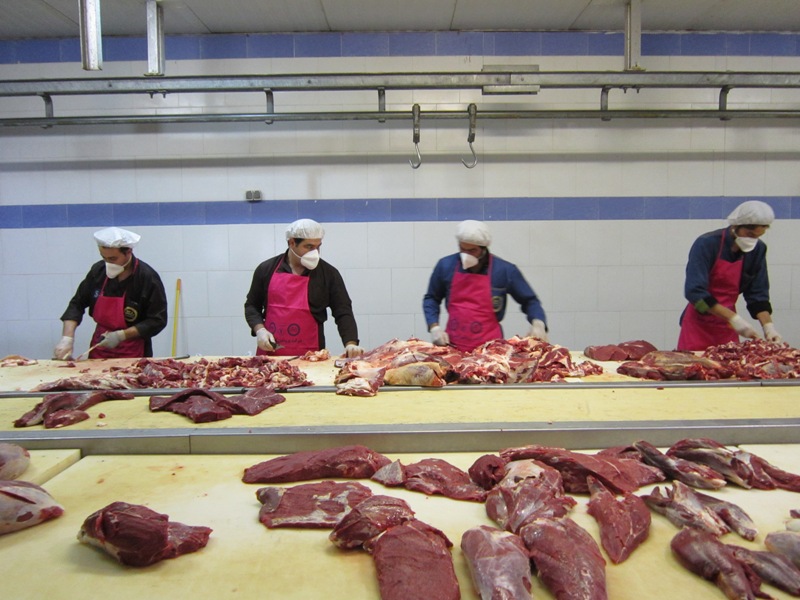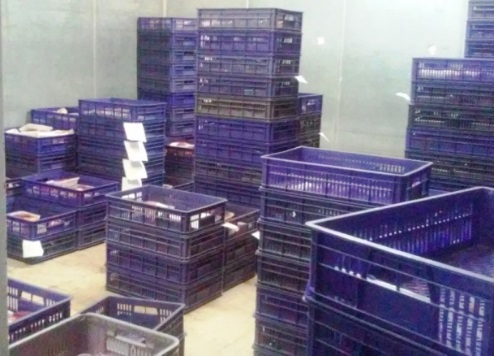ماهنامه شماره 17 (دي ماه 1395)
Protein material derived from slaughtered poultry, sheep, cattle and so on, are one of the important nutrients in the food basket of Iranian families that are perishable by nature. GS1 Iran has taken an initiative to identify and develop solutions for meat supply chain management as a result of this market need and issue. Hence, GS1 Iran has defined the project termed “Automation of sheep production line for protein producers using GS1 Standards “.
This project is to offer a method to determine the originality of fresh protein products using GS1 Traceability Standards and Guidelines. By implementing GS1 standards, it is aimed to secure the needs of the protein producers in storage system automation and also in processes management such as entry of raw materials to the factory, production, ordering, distribution, recall defective products, etc.
A) Identifying the problem by GS1 Iran
the Ordering Department is not informed of the inventory level.
Some customers are dissatisfied and may return the entire order due to lack of one item.
Invoices are not managed systematically, therefore, the invoice information is not visible for Storage personnel and the Financial Departments at the same time.
No facilities exist to avoid repetitive bar codes in the organization.
Packages of foods or inventory items often being displaced.
Loading vans is handled by the man power and deficit of items imposes a substantial loss to the company.
Due to the manual information labeling assembling, the information printed on the food packages do not correspond with the packaging contents, and it causes rejection of products and impose costs to the organization.
The organization is not able to track the causes of quality problems of returned goods.
The organization is not able to restore their baskets and can not keep track of the baskets shipped to buyers.
B) GS1 Traceability Model
A standard method of traceability would provide the internal interaction between various system throughout the entire supply chain. It also facilitate the communication with the other internal systems. In order to create the protein material automation system of the designated company, a ten-step traceability process was planned according to GS1 Standards for this purpose.
If all the participating parties of a supply chain implement the internal and external traceability based on the GS1 model, a complete traceability process will be implemented throughout the entire chain
 .
.
Figure 1 – Traceability capability throughout the supply chains would form within inside and outside of them
Selected Model and Protein Products Supply Processes
Considering the technological limitations along with the expenditures level, the designated production companies of the protein products selected the SPECIFIC Traceability Model for their study. The traceability process has put in to action by the entrance of the material in the company in this Model. To implement the traceability system based on GS1, the general supply chain processes including delivering the Meat products has been developed according to below diagram. The implementation system of the protein company has been started from the blue section of this diagram.
Figure 2 – Tracking Process Design
Implementation and operation processes were performed as follow as shown in Figure1 :
1 – The process of receiving the carcasses of meat from suppliers, transferring them to the morgue, identifying them, and allocating an internal serial number.
2- Delivery of carcasses to entry point of production line (segmentation hall)

Figure 3 – Sheep Production Line
3- Transform and place carcass into multiple packaging consisting of raw products and animal waste, allocating SGTINs to all products, and labeling them with GTIN tags.

Figure 4 – GTIN Sheep thigh meat – 1Kg cellophane pack
4- Deliver GRAI labeled baskets to storage area, each basket with the SGTINs of its internal packages have been allocated SSCC codes.

Figure 5 – SSCC and GRAI- baskets for meet packs
| n18 | n17 | n16 | n15 | n14 | n13 | n12 | n11 | n10 | n9 | n8 | n7 | n6 | n5 | n4 | n3 | n2 | n1 | AI |
| 2 | 1 | 0 | 0 | 0 | 0 | 0 | 0 | 0 | * | * | * | * | * | 6 | 2 | 6 | 0 | (00) |
Figure 6 – SSCC – A Sample
| n15 <= n30 | n14 | n13 | n12 | n11 | n10 | n9 | n8 | n7 | n6 | n5 | n4 | n3 | n2 | n1 | AI |
| PB07G…59XX | 4 | 5 | 0 | 0 | 0 | * | * | * | * | * | 6 | 2 | 6 | ‘0’ | (8003) |
Figure 7 – GRAI – Single Basket
5- Preparation of consignments based on the orders; each order has been allocated a GTIN code, the repacked baskets will be allocated a new SSCC code again which have been linked to the SGTIN of the packages inside of the basket and also to the GDTI of the corresponding invoices.
| n14 <= n30 | n13 | n12 | n11 | n10 | n9 | n8 | n7 | n6 | n5 | n4 | n3 | n2 | n1 | AI |
| F13940119…RKH | 9 | 3 | 1 | 0 | 0 | * | * | * | * | * | 6 | 2 | 6 | (253) |
Figure 8- GDTI – Invoices
6- Loading and shipment of consignments; the GDTI barcodes of each invoice and SSCC of each baskets will be scanned by the delivering person (the driver or the distributor). The orders will be shipped to the customers based on their GLNs upon loading.
| n13 | n12 | n11 | n10 | n9 | n8 | n7 | n6 | n5 | n4 | n3 | n2 | n1 | AI |
| 3 | 5 | 7 | 0 | 4 | 5 | 9 | 7 | 2 | 0 | 6 | 2 | 6 | (410) |
Figure 9 – GLN – a Sample
| n9 <= n30 | n8 | n7 | n6 | n5 | n4 | n3 | n2 | n1 | AI |
| … | 5 | 9 | 7 | 2 | 0 | 6 | 2 | 6 | (8004) |
Figure 10 – GIAI – Vehicles
7- Receiving rejected product is identified by the inventory personnel through scanning the SGTINs of each rejected package which will determine which customer rejected the package. This will be deducted from the customer invoice via online and returned back to the inventory system.
D) The benefits of the GS1 solution
By defining these processes and allocation of GS1 standard codes, GS1 Iran developed and tested required software .Subsequently, GS1 Iran assisted the protein producer companies to benefit from this achievement. It was done by preparation and delivery of required hardware, providing employees with necessary trainings, and cooperating in implementation of the system.
The automation of sheep production line for protein producers has provided following benefits:
A)unique identification of individual product packages
B) reduce human error in different fields
C) expedite business processes
D) provide advanced management reporting dashboard
E) ability to ordering online and customizing orders
F) prevent deficit or extra inventories
G) effective management of baskets
H) online statistical monitoring
I) precise control of rejected product
J) Brand Protection


Left Fig : GTIN + Data Matrix sample Right Fig : GTIN sample



 صاحب امتياز
صاحب امتياز